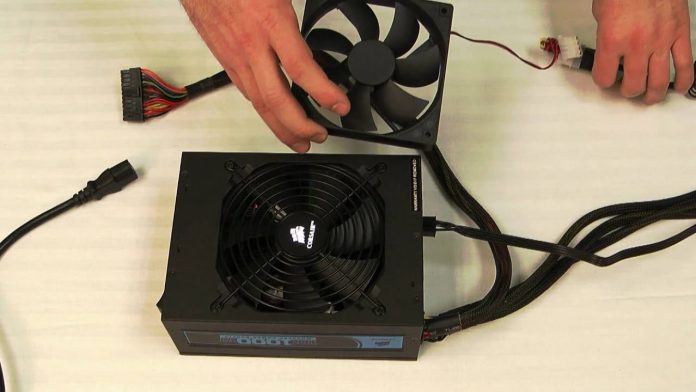A power supply unit is under consistent workload; as the burden increases, the PSU gets overheated. The main job of the PSU fan is to prevent overheating of the supply unit. Commonly, PSU contains two fans to provide complete cooling of the device. Both the fans are helpful with cooling down the supply unit and its components. The fans start to work at different moments per PSU’s execution. If your PSU fan not spinning, it probably isn’t a big deal and could be interpreted easily. Before moving further, let’s understand the working of the PSU fans.
Working of PSU fans:
The fans are usually idle. They don’t move unless the device’s temperature crosses a specific limit. The fans will have to work continuously if you put more load on the PSU. A load is the amount of power generated through your PSU.
Usually, the fans don’t spin in Eco or quiet modes. So do not worry if your fan isn’t spinning; it probably isn’t the right temperature to begin. The fans don’t kick in as long as the PSU is cool and effectively working.
Why is the PSU fan not spinning?
The PSU fan does not have to work all the time; the PSU is fine at maintaining its temperature. The fans are designed to start working when the power surge through the device is significant.
So, if the fan is not spinning, then maybe the device may not work at its full potential. We often confuse the working of the PSU fan with other fans in the machine and panic, expecting the fan to be broken when it’s totally fine.
But what if the problem arises? How to differentiate between the PSU fan not spinning and the fan sitting idle? The easiest way is to keep your ears open for any change in sound when the fan starts to kick in.
You can test your fan’s feasibility using the PSU for output that requires a lot of energy. The fan would start spinning to deflect the overheating of the device.
You must know how your fan usually sounds while working to understand any further issues.
Signs that the PSU fan is damaged
If the fan does not start to spin even after a heavy load of work, then it’s undoubtedly damaged. But you can keep a check on the following changes too.
It probably has some mechanical problems if you hear suspicious sounds like grinding from your PSU while the fan is spinning.
The blade could be bent, or the motor could be damaged. Always be cautious with such sounds to avoid permanent damage to your PSU.
If you see any smoke from your PSU or some sort of smell from your computer, there could be permanent damage. It is advisable to turn off your device immediately and wait for it to cool down. After that, tend to the PSU’s issues before turning it back on. Prevent the damage from spreading to other parts of the PSU; otherwise, it would break down completely.
You must know when your PSU tends to heat, and the fans start spinning, the apparent fraction of temperature after which the fan kicks in. If you don’t know, then you can start now. Perform specific tasks on your device and check what amount of load starts the fan. Knowing your PSU might help you detect the problems quickly.
If your computer shuts down often or shows a lot of blue screens, maybe it is indicating internal damage. You need a fully functioning PSU to procure outputs on your computer, and perhaps the reason why you are meeting dead ends is a damaged PSU. It could be all the parts of your PSU or only one part, like the PSU fan. It is a crucial indication.
If you have any of these above problems, then it’s time for your PSU fan to be fixed or replaced as needed. Sometimes you don’t even require to use your tools while fixing the fan. Most of the time, you have to replace the PSU fan when it becomes rusty and old.
It’s not much of a worry if the PSU fan is not spinning since any problem can be easily undone.
How to Fix the PSU Fan not spinning issue?
Before we begin fixing the PSU fan, you must check all the connections and wirings. Check whether the PSU is appropriately placed. Check with the hardware and software problems, if any, then fix them first.
You must be cautious while working with the PSU. The PSU supplies power to your device, so disassemble it only if you have some experience with it. If you fail while fixing it, you may damage the whole PSU. If you do not feel confident, you should call a technician if a replacement needs to be done. You must also take the necessary precautions while dealing with electronic products.
Placement of the PSU
Proper placement of PSU is absolutely important. The fan must be devoid of any interruptions to spin suitably. The case where the fan is placed must have an adequate supply of air hence correct placement.
Follow the steps to check the PSU:
The PSU should not be working while you examine it. Shut down your device and wait for it to cool before you start working. After that, you need to remove the power supply for the PSU, i.e., unplug the PSU for proper examination. Completely turn off the PSU by turning off the power button if there is any.
Dissemble the PSU to expose the fan. Check for its placement and whether anything is interrupting its spinning.
Check all the wirings around the fan. You must ensure that none of the wires meddle with the blades when the fan moves. Push them away or tape them if they do.
Try spinning the blade with your hands if you can reach it. Suppose you can’t, then do not attempt it. You should not use any metal probe to spin it as it may damage the fan.
Check the position of PSU. Ensure it is placed such that it can pull cool air from outside. The fan must have enough space inside the case to draw air. If it does not have the space, then change its placement.
You have examined the position and working of the fan and ensured it’s smooth spinning. If you didn’t find any problems here, then be reassured that there is no problem in turning your fan on.
Connections of the PSU
Many times it’s not the fan that has problems but the wires connecting to it. It helps to check the wiring as it may help better function your computer or another device.
The process is a bit tacky, so be delicate while handling things.
Begin by unplugging the motherboard from the PSU. Again be careful with the wires and board.
Check the connections for any damage, whether the wires are cracked or ripped. Any irregularity is readily visible at first sight.
Replace the wires if you find any abnormality. If not, then place the board back in its place without doing any further damage to the wirings.
You should also check the power supply to the PSU. The PSU often does not receive an adequate power supply to start the fan hence the reason for its inefficiency.
Cleanliness of the PSU
After you open the PSU unit, you will find dust settled in the corners and crevices. The dust hampers the functioning of the fan. You will also find dust lingering in the fan vents.
Follow the steps to clean the fan:
We will clean the fan using pressured or compressed air. Place the fan properly and point the airflow towards it.
Start blowing the air towards the fan in to and from motion. It will remove the dust that settles into vents.
Dust the case before you reassemble things and close the PSU.
Now you will be assured about the problem causing your fan not to spin. After you have cleared out the dust, place everything as it was.
Software Adjustments
This bit requires experience. You can only perform it if you are well versed with PSU settings and different modes of working for PSU. You will need the PSU control software to make any changes for it, if necessary.
If you have prior made any changes, like adding a custom fan, then you need to reset it back. If the PSU is in Eco mode or silent mode, change it to a more robust mode. We need the fan to start spinning at low power, unlike how it was designed.
Many PSUs have external controls rather than software settings. You need to manually change it as required or reset it if you have changed it before.
Some PSUs do not have such a setting; the manufacturer has set them to a default setting. You cannot do much about that.
Contact the Manufacturer
After checking the connections, examining the PSU, and all the mentioned steps, you do not find any problem with the computer or PSU; then, you would need to replace it. Before that, you must contact the manufacturer.
They will provide you with solutions to handle the broken fan. They may advise you on different procedures to start your fan or check for any absurdities.
If you have a warranty for your PSU, then contact your manufacturers and ask them to fix your PSU fan or ask for any replacements required.
A PSU fan must be able to last long. If it doesn’t, then it’s time for you to follow the above-mentioned procedures and fix it before it affects the motherboard of the PSU. And after you have set it, the PSU will be ready to function fully.
Experiencing difficulties with your Device, check out our “How To” page on how to resolve some of these issues.














